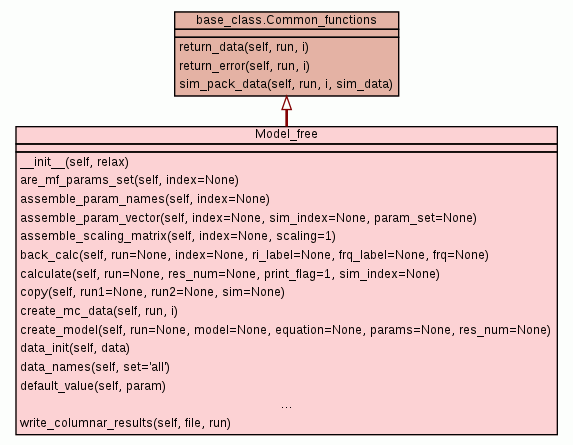|
|
|
|
|
are_mf_params_set(self,
index=None)
Function for testing if the model-free parameter values are set. |
source code
|
|
|
|
assemble_param_names(self,
index=None)
Function for assembling various pieces of data into a Numeric
parameter array. |
source code
|
|
|
|
assemble_param_vector(self,
index=None,
sim_index=None,
param_set=None)
Function for assembling various pieces of data into a Numeric
parameter array. |
source code
|
|
|
|
assemble_scaling_matrix(self,
index=None,
scaling=1)
Function for creating the scaling matrix. |
source code
|
|
|
|
back_calc(self,
run=None,
index=None,
ri_label=None,
frq_label=None,
frq=None)
Back-calculation of relaxation data from the model-free parameter
values. |
source code
|
|
|
|
calculate(self,
run=None,
res_num=None,
print_flag=1,
sim_index=None)
Calculation of the model-free chi-squared value. |
source code
|
|
|
|
copy(self,
run1=None,
run2=None,
sim=None)
Function for copying all model-free data from run1 to run2. |
source code
|
|
|
|
create_mc_data(self,
run,
i)
Function for creating the Monte Carlo Ri data. |
source code
|
|
|
|
create_model(self,
run=None,
model=None,
equation=None,
params=None,
res_num=None)
Function to create a model-free model. |
source code
|
|
|
|
data_init(self,
data)
Function for initialising the data structures. |
source code
|
|
|
|
|
|
|
|
|
|
delete(self,
run)
Function for deleting all model-free data. |
source code
|
|
|
|
determine_param_set_type(self,
run=None)
Determine the type of parameter set. |
source code
|
|
|
|
disassemble_param_vector(self,
index=None,
sim_index=None)
Function for disassembling the parameter vector. |
source code
|
|
|
|
duplicate_data(self,
new_run=None,
old_run=None,
instance=None)
Function for duplicating data. |
source code
|
|
|
|
eliminate(self,
name,
value,
run,
i,
args)
Local tm model elimination rule
~~~~~~~~~~~~~~~~~~~~~~~~~~~~~~~ |
source code
|
|
|
|
get_param_names(self,
run,
i)
Function for returning a vector of parameter names. |
source code
|
|
|
|
get_param_values(self,
run,
i,
sim_index=None)
Function for returning a vector of parameter values. |
source code
|
|
|
|
grid_search(self,
run,
lower,
upper,
inc,
constraints,
print_flag,
sim_index=None)
The grid search function. |
source code
|
|
|
|
grid_search_setup(self,
index=None)
The grid search setup function. |
source code
|
|
|
|
|
|
|
map_bounds(self,
run,
param)
The function for creating bounds for the mapping function. |
source code
|
|
|
|
minimise(self,
run=None,
min_algor=None,
min_options=None,
func_tol=None,
grad_tol=None,
max_iterations=None,
constraints=0,
scaling=1,
print_flag=0,
sim_index=None)
Model-free minimisation. |
source code
|
|
|
|
model_setup(self,
run=None,
model=None,
equation=None,
params=None,
res_num=None)
Function for updating various data structures depending on the model
selected. |
source code
|
|
|
|
model_statistics(self,
run=None,
instance=None,
min_instances=None,
num_instances=None)
Function for returning k, n, and chi2. |
source code
|
|
|
|
num_instances(self,
run=None)
Function for returning the number of instances. |
source code
|
|
|
|
read_columnar_col_numbers(self,
header)
Function for sorting the column numbers from the columnar formatted
results file. |
source code
|
|
|
|
read_columnar_diff_tensor(self)
Function for setting up the diffusion tensor from the columnar
formatted results file. |
source code
|
|
|
|
read_columnar_find_index(self)
Function for generating the sequence and or returning the residue
index. |
source code
|
|
|
|
read_columnar_model_free_data(self)
Function for reading the model-free data. |
source code
|
|
|
|
read_columnar_param_set(self)
Function for reading the parameter set. |
source code
|
|
|
|
read_columnar_pdb(self,
print_flag=1)
Function for reading the PDB file. |
source code
|
|
|
|
read_columnar_relax_data(self)
Function for reading the relaxation data. |
source code
|
|
|
|
read_columnar_results(self,
run,
file_data,
print_flag=1)
Function for reading the results file. |
source code
|
|
|
|
read_columnar_sequence(self)
Function for generating the sequence. |
source code
|
|
|
|
read_columnar_xh_vect(self)
Function for reading the XH unit vectors. |
source code
|
|
|
|
remove_tm(self,
run,
res_num)
Function for removing the local tm parameter from the model-free
parameters. |
source code
|
|
|
|
|
|
|
|
|
|
return_grace_string(self,
param)
Function for returning the Grace string representing the parameter
for axis labelling. |
source code
|
|
|
|
|
|
|
return_value(self,
run,
i,
param,
sim=None)
Function for returning the value and error corresponding to 'param'. |
source code
|
|
|
|
select_model(self,
run=None,
model=None,
res_num=None)
Function for the selection of a preset model-free model. |
source code
|
|
|
|
set(self,
run=None,
value=None,
error=None,
param=None,
scaling=1.0,
index=None)
Model-free set details
~~~~~~~~~~~~~~~~~~~~~~ |
source code
|
|
|
|
set_error(self,
run,
instance,
index,
error)
Function for setting parameter errors. |
source code
|
|
|
|
sim_init_values(self,
run)
Function for initialising Monte Carlo parameter values. |
source code
|
|
|
|
sim_return_chi2(self,
run,
instance)
Function for returning the array of simulation chi-squared values. |
source code
|
|
|
|
sim_return_param(self,
run,
instance,
index)
Function for returning the array of simulation parameter values. |
source code
|
|
|
|
sim_return_selected(self,
run,
instance)
Function for returning the array of selected simulation flags. |
source code
|
|
|
|
sim_set_selected(self,
run,
instance,
select_sim)
Function for returning the array of selected simulation flags. |
source code
|
|
|
|
skip_function(self,
run=None,
instance=None,
min_instances=None,
num_instances=None)
Function for skiping certain data. |
source code
|
|
|
|
unselect(self,
run,
i,
sim_index=None)
Function for unselecting models or simulations. |
source code
|
|
|
|
write_columnar_line(self,
file=None,
num=None,
name=None,
select=None,
select_sim=None,
data_set=None,
nucleus=None,
model=None,
equation=None,
params=None,
param_set=None,
s2=None,
s2f=None,
s2s=None,
local_tm=None,
te=None,
tf=None,
ts=None,
rex=None,
r=None,
csa=None,
chi2=None,
i=None,
f=None,
g=None,
h=None,
warn=None,
diff_type=None,
diff_params=None,
pdb=None,
pdb_model=None,
pdb_heteronuc=None,
pdb_proton=None,
xh_vect=None,
ri_labels=None,
remap_table=None,
frq_labels=None,
frq=None,
ri=None,
ri_error=None)
Function for printing a single line of the columnar formatted
results. |
source code
|
|
|
|
write_columnar_results(self,
file,
run)
Function for printing the results into a file. |
source code
|
|
|
Inherited from base_class.Common_functions:
return_data,
return_error,
sim_pack_data
|

